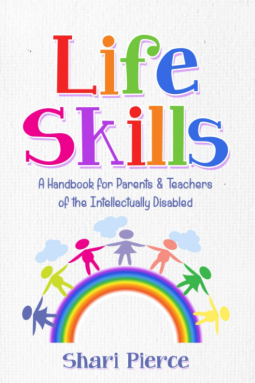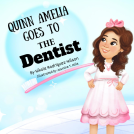
Life Skills
A Handbook for Parents & Teachers of the Intellectually Disabled
by Shari Pierce
This title was previously available on NetGalley and is now archived.
Send NetGalley books directly to your Kindle or Kindle app
1
To read on a Kindle or Kindle app, please add kindle@netgalley.com as an approved email address to receive files in your Amazon account. Click here for step-by-step instructions.
2
Also find your Kindle email address within your Amazon account, and enter it here.
Pub Date 9 Feb 2023 | Archive Date 3 Apr 2023
Talking about this book? Use #LifeSkills #NetGalley. More hashtag tips!
Description
From classroom to home, empower yourself with the knowledge and skills to make a difference in a special needs child's life.
This book is intended for those whose lives are touched by people with intellectual disabilities. In it you will find ideas, suggestions, and actionable advice on topics that are concerning to parents and teachers, including topics you may not have even thought of before!
My professional and personal experiences give me a unique perspective and a deep understanding of children and adults with special needs. My thirty-three years in the classroom will benefit teachers, both new and experienced, who are working with this special population, perhaps for the first time. And as the sibling of an adult with disabilities, I understand the challenges that parents face as they do their best to raise their special child and work with teachers and others in the school system.
There are topics in this book that are geared toward teachers, such as “Working With Your Aides” or “Let’s Get Out of Here - A Guide to Class Trips and Outings.” Other topics are more for parents, such as “Take My Family…Please” or “Your Child’s Future.” In both cases, however, parents and teachers can benefit from reading all sections and thus gaining a greater understanding of each others’ roles, fears, concerns, and strengths. For clarity and ease of use, many sections are labeled for parents or teachers—but all are welcome! Family members besides parents can learn about the unique challenges—and delights—of raising a special needs child. School staff, even those whose interactions with special children is peripheral, can benefit greatly by learning more about reaching this population and supporting the teachers on the front lines.
Part Four of this book can serve as a curriculum and activity guide. Many activities are given for classroom situations, but most can easily be adapted for the home setting. This section is unique in that it not only gives ideas for teaching and practicing skills, but it also explains the how and why of instruction, allowing you to learn optimal ways to teach an area and what the barriers to successful understanding may be.
Teacher or parent, administrator or grandparent, special area teacher or friend—you will find many ways to teach, understand, and care for the most special children in your life!
Available Editions
| ISBN | 9798987718506 |
| PRICE | |
Available on NetGalley
Featured Reviews
A comprehensive guide to understanding, teaching, and caring for special needs children. The author's personal and professional experiences provide a unique and invaluable perspective on the challenges and joys of raising a special needs child. The book covers topics for both parents and teachers, offering actionable advice and practical solutions, as well as a curriculum and activity guide for teaching and practicing skills.
Empower yourself to make a difference in the life of a special needs child...
A powerful and inspiring guide for anyone who wants to understand, teach, and care for special needs children. The author's deep understanding of the challenges and joys of raising a special needs child shines through on every page, and her actionable advice and practical solutions will benefit parents, teachers, and administrators alike. The curriculum and activity guide in Part Four is particularly helpful, providing a wealth of ideas and strategies for teaching and practicing skills in both the classroom and the home. This book is a must-read for anyone who wants to empower themselves with the knowledge and skills to make a real difference in the lives of special needs children.
 JB S, Reviewer
JB S, Reviewer
Life Skills, by Shari Pierce, targets those who assist the intellectually disabled. One imagines this group comprises teachers or those who wish to teach. In reading through the material, though, I was reminded of a lot of my own elementary school experiences. I would say, then, that the audience I actually wider than this specific subset and that what the book is really teaching is “structured empathy” for dealing with anyone or anything that might not always have the full arsenal of communication ability at their disposal.
This book could, for instance, apply to people who have had a stroke and are trying to re-learn certain life skills.
The specialty, however, is clearly what Ms. Pierce has 30 years of experience in doing, which is being in a structured classroom setting teaching those who would be considered to be “disabled” in one way or another. The emphasis is on teenagers down, although I have seen these same techniques used on anyone at any time regardless of their age if it is appropriate. It is a delicate line to walk in a politically charged climate to say whether or not what one has to say might be deemed potentially “demeaning” since our culture has an attitude that suggests that “being need to be taught as children” is fundamentally “insulting” even though some heavy-hitting books on Zen and the Bible suggest we should not be quite so quick to take offense and consider that perhaps children have the “better deal” than adults in some important ways.
I would say then that Ms. Pierce does a good job of “getting on” with the material she has without having to adopt a stilted vocabulary in relation to the job she is performing. Where she shines in particular is having built a tremendous trove of reference materials and exercises that she has used in her classroom setting over the years, as well as setting the proper parameters of expectation for what should be considered “success”. Additionally, there are tips that concern fostering what one would term a “learning environment” so that anyone who is teaching people that need these skills are not discouraged by attitudes from the teacher that might prove damaging to that process.
I particularly enjoyed the snippets of Ms. Pierces own life, where she shares some of her experiences and how she came to an early appreciation of the later path she would follow in her chosen teaching career.
I also think her idea of having a newsletter is an important piece to having any kind of classroom since otherwise the only interface or channel to the class will be the child. Children are not always going to discuss what they are learning, nor will they be able to communicate it in such a manner that an adult always apprehends the true nature of the classroom. A newsletter can help with this obvious gap.
There are a multitude of activities in this book for the classroom for teaching those life skills such as telling time, numbering things, letters and other fundamental areas. Again, I would suggest the curriculum could equally well fit a lot of elementary school teachers or even possibly nursing homes depending on the needs there.
I think the classroom setting that Ms. Pierce taught within, however, is probably under pressure like never before in the modern climate we are in post COVID and I hope that some of the experience she puts in this book is not lost since it seems like our civilization has forgotten some of these essential “life skills” and how to treat one another with a basic respect. Maybe we all need to go back to elementary school long enough to remember how we were before teachers like Ms. Pierce came along with some patience, understanding, and empathy. Whether it is dealing with bodily changes which do not stop at childhood and how to relate to that or how to manage a play with challenging roles, there is something for everyone in this book and the apparent title should not put off teachers or caregivers of any variety.




